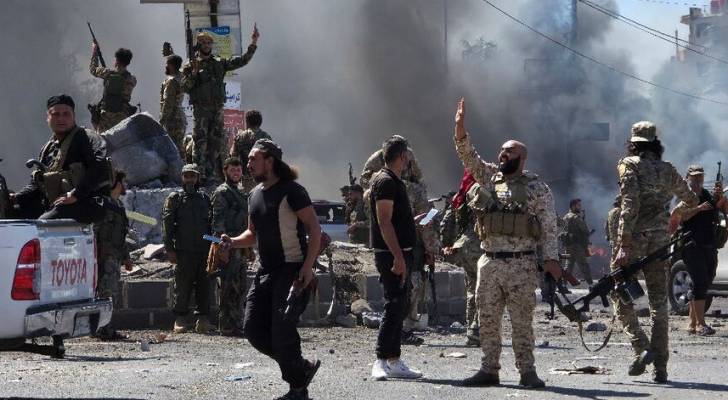Armed groups allegedly affiliated with the government druing Sweida events in July, 2025.
Amnesty says Syria govt forces, allies executed dozens of Druze in Sweida
Amnesty International has accused Syrian government forces and affiliated groups of carrying out at least 46 extrajudicial executions of Druze men and women during days of violence in Sweida in July.
The organization says its findings amount to crimes under international law.
According to Amnesty, verified videos and eyewitness testimonies show armed men in military and security uniforms, some bearing official badges, executing unarmed people inside homes, a school, a hospital, a ceremonial hall, and in Tishreen square.
The investigation documented the deliberate killing of 44 men and two women on 15 and 16 July. It also reported the mock execution of two older persons.
Diana Semaan, Amnesty International’s Syria Researcher, said:
“When government security or military forces deliberately and unlawfully kill someone, or when affiliated forces do so with government complicity or acquiescence, that constitutes an extrajudicial execution, which is a crime under international law. The Syrian government must promptly, independently, impartially and transparently investigate these executions and hold perpetrators accountable in fair proceedings, without recourse to the death penalty.”
Amnesty noted that armed men in Sweida directed sectarian slogans at Druze civilians and forcibly shaved the moustaches of religious men, a practice that carries deep cultural significance in the community.
Testimonies and Evidence
Amnesty interviewed 13 people inside Sweida and two abroad. Among them, eight lost family members in the executions. Witnesses described relatives being shot in front of them, bodies left in unfinished buildings, and entire families executed after government forces entered neighborhoods under curfew.
One woman said her brothers and nephew were taken from her home by soldiers who promised safety, only to be found killed hours later. Another man recounted watching his three sons and three nephews gunned down at a checkpoint by men in black uniforms.
The organization’s Evidence Lab verified 22 videos and photos between 15 July and 10 August, as well as CCTV footage from Sweida’s national hospital, where medical worker Mohammed Rafiq al-Bahsas was executed in front of colleagues. At least 15 armed men were filmed inside the hospital, including individuals in General Security uniforms and others allegedly wearing black patches bearing the Islamic declaration of faith.
Amnesty stressed that fighters filmed themselves committing the killings. “Instead of fearing justice, men in military and security uniforms, and men affiliated with them, filmed themselves executing people in Sweida. An independent and impartial investigation is crucial,” said Semaan.
Background to the Violence
Clashes in southern Syria began between Druze armed groups and Bedouin tribal fighters on 11–12 July. On 15 July, government forces entered Sweida “to restore stability,” imposing a curfew. That same day, 'Israeli' airstrikes killed at least 15 Syrian government soldiers. Reports of abuses by government forces escalated fighting, which ended with their withdrawal on 16 July.
Amnesty also received credible reports of abductions carried out by Druze armed groups and Bedouin fighters between 17 and 19 July, which it is still investigating.
The group said violence in Sweida, combined with previous killings of hundreds of Alawite civilians earlier this year, shows a pattern of sectarian-based violence in Syria. More than 2,000 people were killed in Sweida during July’s unrest, according to local reports, while at least 1,500 Alawites were killed in Latakia in March. A Reuters investigation linked that violence to officials in Damascus.
Government investigation
On 22 July, Syrian Defence Minister Merhaf Abu Qasra acknowledged “shocking and serious violations committed by an unknown group wearing military uniforms in the city of Sweida.” Two months earlier, he had announced that former armed groups had been absorbed into the Syrian army, warning others to comply or face consequences.
President Ahmed al-Sharaa pledged to hold perpetrators accountable. On 31 July, the Ministry of Justice formed a committee to investigate the Sweida killings. The Interior Ministry condemned circulating videos of “field executions by unidentified individuals,” calling the acts serious crimes punishable by law. It said urgent investigations were underway to identify and arrest those responsible.
The National Investigative Committee confirmed its work under Decision No. 1287 of 31 July, focusing on investigating violations and referring perpetrators to court. It said dozens of suspects were already under review.
The Ministry of Defence said it was examining the affiliation of individuals behind the violations and instructed that no formations enter operational areas without clearance. It pledged “the harshest punishments” against those involved, even if they were part of defence units.
Related investigations in Latakia
The National Committee for Investigation and Fact-Finding in Syria announced it had identified 298 suspects in the Latakia violence in March that killed 1,426 people. Committee spokesperson Yasser al-Farhan said the figure was preliminary and based on family testimonies, hundreds of witness accounts, and analysis of photos and videos.
The committee claimed remnants of armed groups linked to the former Assad regime were behind the Latakia attacks.




